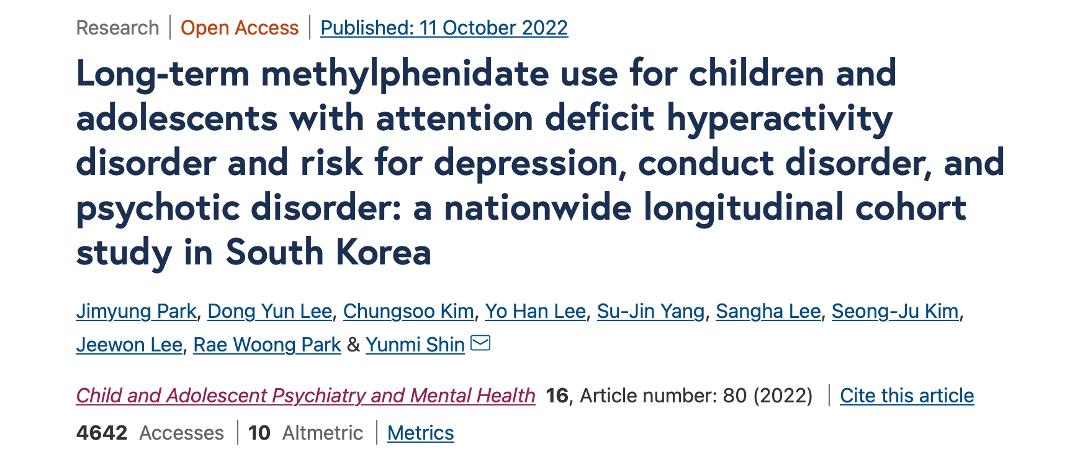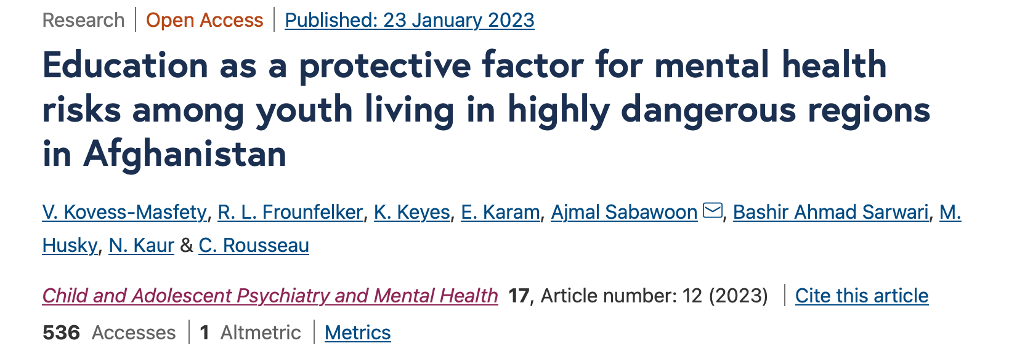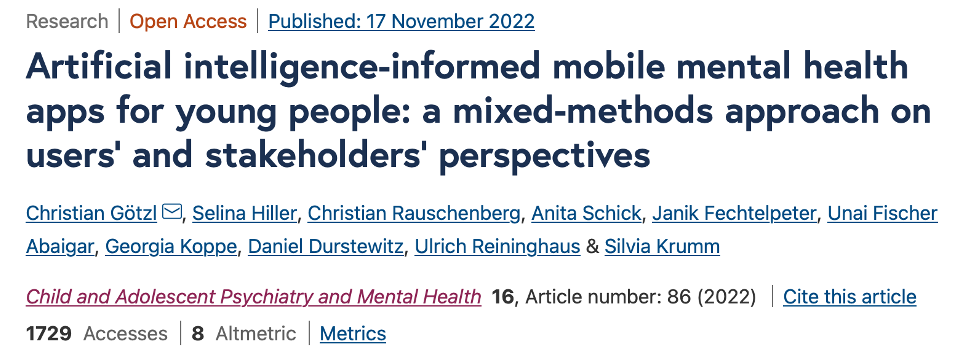CAPMH Corner (Updated Mar 2023)
By: Lakshmi Sravanti, India, Associate Editor, CAPMH
Child and Adolescent Psychiatry and Mental Health (CAPMH) is the official IACAPAP Journal. The "CAPMH Corner" of the March 2023 issue of IACAPAP Bulletin summarizes the following three studies recently published in CAPMH – Long‑term methylphenidate use for children and adolescents with attention deficit hyperactivity disorder and risk for depression, conduct disorder, and psychotic disorder: a nationwide longitudinal cohort study in South Korea (Park et al., 2022), Education as a protective factor for mental health risks among youth living in highly dangerous regions in Afghanistan (Kovess‑Masfety et al., 2022) and Artificial intelligence‑informed mobile mental health apps for young people: a mixed‑methods approach on users’ and stakeholders’ perspectives (Götzl et al., 2022).
Park et al., (2022) highlight the need to evaluate the neuropsychiatric effects of long-term Methylphenidate (MPH) use in children and adolescents with ADHD (Attention Deficit Hyperactivity Disorder). They further substantiate the need to study the long-term impact of MPH use on adverse psychiatric outcomes by mentioning that the Committee for Medicinal Products for Human Use suggested more research is needed in this area ((EMEA) TEMA. Methylphenidate article 31 referral—annex I, II, III, IV. 2007.).
The team conducts a population-based cohort study to using data from Health Insurance Review and Assessment service, a nationwide claims database in South Korea. They collect data of all 6 – 17-year-old patients with ADHD (n = 336,098) in South Korea enrolled in their national health insurance scheme from January 2016 to March 2021 in their observational study. They consider 2019 as the time-at-risk window. The patients were required to have continuous MPH treatment from 1 January 2019 to 31 December 2019 to assess the risk of the outcomes during MPH treatment. They define long-term MPH treatment as “at least 365 days and less than 730 days” and short-term as “an exposure of less than 365 days”. They include only the first diagnosed events of depressive disorder, psychotic disorder, and conduct disorder and oppositional defiant disorder (ODD) as outcomes. They use a 1:2 propensity score matching to reduce the effects of confounding factors, and Cox proportional hazards model to evaluate the safety of MPH. In addition, they conduct three sensitivity analyses using different definitions of treatment periods, exclusion of non-stimulant ADHD medications, and comparison to non-MPH users to assess the robustness of the findings. They set statistical significance at P < 0.05.
The authors record a mean age of 8.8 ± 2.6 years and 8.6 ± 2.4 years of long-term and short-term users and a mean daily MPH dose of 22.2 ± 8.4 mg and 20.9 ± 8.2 mg after propensity score matching for the long- and short-term MPH users respectively. They report that the risk of depressive disorder (HR, 0.70 [95% CI 0.55–0.88]; P = 0.003), conduct disorder and ODD (HR, 0.52 [95% CI 0.38–0.73]; P < 0.001) is lower in long-term MPH use than short-term MPH use and that of psychotic disorder was not different between long- and short-term MPH use in the primary analysis (HR, 0.83 [95% CI, 0.52–1.32]; P = 0.424). They underscore their study’s strengths such as – longer follow-up time, larger sample size, and use of propensity score to overcome potential confounding factors. They also mention its limitations – they did not subtype ADHD or include familial factors owing to the limitations of the claims database. They did not have information on patients’ management except for the number of prescription days and that one year may not be an accurate cut-off to distinguish between short-term and long-term MPH use. They suggest that long-term MPH treatment need not be contraindicated in children with ADHD and comorbidities such as depression, conduct disorders, and psychotic disorders. However, suggest further research to address the possibility of unmeasured confounders.
Kovess‑Masfety et al., (2022) elaborate on the education system in Afghanistan and the challenges faced by young children to access education. They set out to evaluate the mental health of Afghan children living in regions of conflict and the association of mental health with school attendance.
The authors carry out multi-stage stratified cluster sampling from eight (16 provinces) regions of Afghanistan. They assign a score to each province in accordance with levels of Taliban or Isis (Daesh) activities reported by a French NGO “Centre d’Etudes et de Recherches Documentaires sur l’Afghanistan” (CEREDAF) for the year 2017 to estimate exposure to dangerous situations. Within each province, the Central Statistical Organization (CSO) randomly samples clusters, resulting in a total of 320 clusters countrywide. They mobilize a total of 64 teams of two individuals (one male and one female staff) for data collection. There is one supervisor per province to manage the administrative aspects and coordinate the data collection process. They collect data between January and July 2017. Surveyors select 14 households per cluster randomly and complete questionnaires. The team sets recruitment goals of 542 adults per region (a total of 4336 adults countrywide). They report a household participation rate of 90% (ranging from 86 to 93% depending on the region). They include the sample of parents who report an index child of 7 years age or older resulting in a sample of 2707 responses (63.87% mothers; 18.54% fathers). They ask the participants to indicate whether or not their child currently attended school and use the parent version of the Strengths and Difficulties Questionnaire (SDQ, which was translated and validated in Dari and Pashtu and previously used in Afghanistan (Panter-Brick C, et al., 2009) to asses child mental health. They compute one-way prevalence comparisons using Pearson chi-square tests and conduct multivariate logistic regressions using STATA “logit” command to analyse the data. They present AOR (Adjusted Odd Ratios) were presented with their 95% confidence intervals.
The team reports that 29.42% of girls did not attend school vs 15.29% of boys (P < 0.001). This trend persisted across all age groups, children with a parent with very little or no education were much more likely to not attend school (24.50%) compared to those with a parent with at least some education (13.55%), P < 0.001. They note peer relationships problems among 82.86% of children, over half of the children had an elevated total difficulties score (52.75%) and, conduct problems were more frequent among boys than among girls (P < 0.0001). They do not report any differences between rural and urban areas, except for any impairment, which was greater in rural than in urban areas: 13.46% versus 9.42% (P = 0.005). They report that the level of the terrorist threat was significantly associated with increased odds of each of the mental health dimensions considered (after controlling for all relevant variables), with the exception of impairment and attending school was associated with lower odds of emotional problems (AOR = 0.65, P < 0.0001) and lower odds of impairment (AOR = 0.67, P = 0.007). However, also note that school attendance was associated with greater odds of peer relationship problems (AOR = 1.96, P < 0.001).
The authors acknowledge the limitations of their current study – owing to its cross-sectional design, data based on parental reports, cultural limitations of SDQ scoring and the possibility of sampling bias. In addition, they highlight that parental mental health was not assessed, the proportion of girls differed across regions and some highly dangerous areas of the country were excluded from the study. They conclude that Afghan children living in dangerous areas suffer from a high level of traumatic events reflected by high levels of symptoms. They reiterate the need to promote prevention programs at the country level and develop adequate interventions integrated into primary care as planned in the Afghanistan Mental health Strategy. They recommend further research on protective factors in places where children’s lives (especially the lives of young girls), are far from what is experienced in many other places in the world and epidemiological studies in Afghanistan (in view of multiple adverse experiences), as well as children who leave the area, with or without their parents.
Götzl et al., (2022) discuss the place of Artificial Intelligence (AI)-informed Ecological Momentary Assessment (EMA)/Ecological Momentary Intervention (EMI) mHealth apps in the area of mental health promotion and mental disorder prevention. They establish a need to know the perspectives of young users to tailor-make these apps for them. They conduct an exploratory study to inform future app development by considering the subjective perspectives of young individuals and key stakeholders regarding their preferences, needs, and concerns.
The team carries out a convergent parallel mixed-method study. They conduct focus group discussions with young people (n=8) and expert interviews (school psychologists, pedagogues, media specialists, mHealth app developers; n=5) to collect qualitative data and an online survey (n=666) for quantitative data acquisition. They analyse the qualitative data using structural content analysis and use descriptive statistics to report findings from quantitative data. Overall, they report that more than two-thirds of young people have experience with mHealth apps, and 60% use regular 1–2 apps regularly. They identify four major themes through qualitative data (Concepts of mental health, Current use of mHealth apps in young people, AI use in the context of mHealth apps, Recommendations for AI–informed mHealth apps with EMA/EMIs) and complement them with quantitative findings. They report that participants share pragmatic attitudes towards data sharing and safety practices, implying openness to share data if it adds value for users and if the data request is not too intimate, however demand transparency of data usage and control over personalization. They complement these findings with statistics from quantitative analysis - that a minority (17%) feel negative about the application of AI in general, and 19% are negative about the embedding of AI in mHealth apps. Further, they state that experts perceive AI-informed mHealth apps as a complementary solution to on-site delivered interventions in future health promotion among young people.
The authors acknowledge limitations with regard to sample size and those owing to the online format of the survey and recommend future studies to conduct a greater number of focus groups with diverse participants. They conclude by suggesting that app developers involve young users in the decision-making process and aim for user–centered approaches on mobile applications with EMA & EMIs.
REFERENCES:
- Götzl, C., Hiller, S., Rauschenberg, C. et al. Artificial intelligence-informed mobile mental health apps for young people: a mixed-methods approach on users’ and stakeholders’ perspectives. Child Adolesc Psychiatry Ment Health 16, 86 (2022). https://doi.org/10.1186/s13034-022-00522-6
- Kovess-Masfety, V., Frounfelker, R.L., Keyes, K. et al. Education as a protective factor for mental health risks among youth living in highly dangerous regions in Afghanistan. Child Adolesc Psychiatry Ment Health 17, 12 (2023). https://doi.org/10.1186/s13034-022-00548-w
- Park, J., Lee, D.Y., Kim, C. et al. Long-term methylphenidate use for children and adolescents with attention deficit hyperactivity disorder and risk for depression, conduct disorder, and psychotic disorder: a nationwide longitudinal cohort study in South Korea.Child Adolesc Psychiatry Ment Health 16, 80 (2022). https://doi.org/10.1186/s13034-022-00515-5
- Panter-Brick C, et al. Violence, suffering, and mental health in Afghanistan: a school-based survey. Lancet. 2009;374(9692):807–16.




